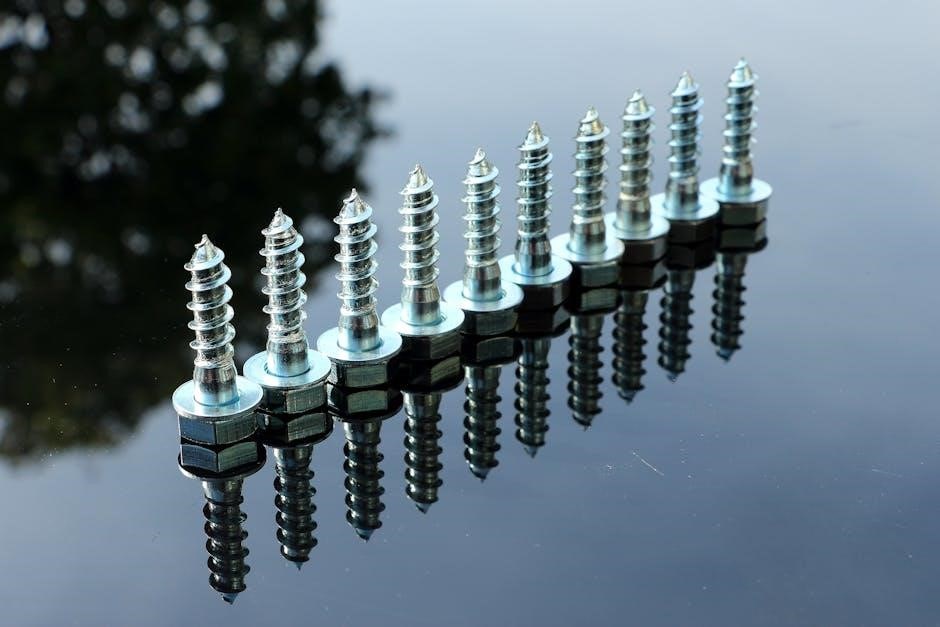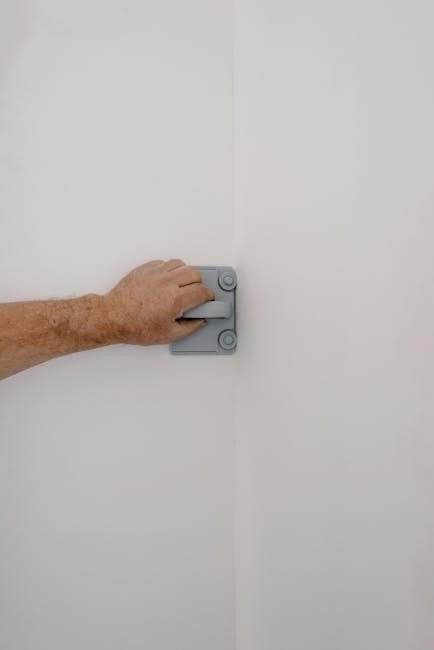A 5 lug bolt pattern is a common wheel configuration‚ especially in passenger cars and SUVs․ It involves measuring the distance between lug holes to ensure proper fitment․ Historically‚ Ford introduced this pattern in the late 1920s‚ making it a standard for many vehicles․ Understanding 5 lug patterns is crucial for safety and compatibility‚ as incorrect measurements can lead to wheel misalignment․ This guide will explore SAE and metric patterns‚ tools‚ and tips for accurate measurement to ensure a secure and proper wheel installation․
1․1 Definition and Overview
A 5-lug bolt pattern refers to the arrangement of five wheel studs or bolt holes on a vehicle’s wheel hub․ It is a common configuration found in many passenger cars‚ SUVs‚ and trucks․ The pattern is defined by the distance between the centers of the bolts‚ measured in inches or millimeters․ This measurement is critical for ensuring proper wheel fitment and safety․ Historically‚ Ford popularized the 5-lug pattern in the late 1920s‚ making it a standard for modern vehicles․ Understanding this pattern is essential for selecting the right wheels and maintaining optimal vehicle performance․
1․2 Historical Background and Evolution
The 5-lug bolt pattern has a rich history‚ dating back to the late 1920s when Ford first introduced it․ This innovation replaced earlier 4-lug designs‚ offering improved stability and load capacity․ Over time‚ the pattern evolved to accommodate various vehicle types‚ from passenger cars to heavy-duty trucks․ The development of both SAE (inch) and metric standards allowed for global compatibility․ Today‚ the 5-lug pattern remains a widely used configuration‚ with advancements in materials and engineering ensuring its reliability and performance across diverse applications․

Importance of Understanding Bolt Patterns
Understanding bolt patterns is crucial for ensuring wheel safety and preventing mechanical issues․ Accurate measurements guarantee proper fitment‚ avoiding vibration and damage․ Essential for both OEM and aftermarket applications․
2․1 Why Bolt Patterns Matter for Vehicle Safety
Accurate bolt patterns are critical for vehicle safety‚ ensuring wheels fit securely․ Incorrect patterns can lead to loose wheels‚ vibration‚ and potential failure‚ causing accidents․ Proper fitment prevents misalignment‚ enhancing stability and braking performance․ Measuring tools like templates or digital gauges help verify patterns‚ avoiding risks․ Understanding bolt patterns ensures safe and reliable vehicle operation‚ making it essential for drivers and technicians alike․ Neglecting this can compromise safety‚ emphasizing the need for precise measurements and correct wheel installation․
2․2 Consequences of Incorrect Bolt Patterns
Incorrect bolt patterns can lead to severe safety hazards‚ including loose wheels and potential detachment while driving․ This can cause loss of vehicle control‚ accidents‚ and damage to the vehicle or surrounding property․ Misaligned wheels may also result in uneven tire wear‚ reducing traction and braking efficiency․ In extreme cases‚ improper fitment can lead to wheel failure‚ especially at high speeds․ Ensuring accurate bolt pattern measurements is essential to prevent these risks and maintain overall vehicle safety and performance․ Proper installation is critical to avoid such dangerous consequences․

How to Measure a 5 Lug Bolt Pattern
Measure the distance between the centers of two opposite lug holes using a template or direct measurement․ Skip one hole to determine the bolt circle diameter accurately․
3․1 Step-by-Step Measurement Guide
To measure a 5 lug bolt pattern‚ start by gathering a ruler‚ calipers‚ or a bolt pattern template․ Locate the center of one lug hole and measure to the center of the hole two positions away․ For example‚ measure from hole 1 to hole 3․ This distance is the bolt circle diameter․ If using a template‚ align it with the lug holes to identify the pattern instantly․ Ensure accuracy by skipping one hole between measurements․ Record the diameter to determine the correct bolt pattern‚ such as 5×5″ or 5x127mm‚ for proper wheel fitment․
3․2 Measuring Without a Template
Measuring a 5 lug bolt pattern without a template requires precision․ Start by selecting a starting lug hole and measure to the center of the next hole in the sequence․ Skip one hole and measure the distance between the centers of the two holes․ This distance is the bolt circle diameter․ For accuracy‚ repeat the process for multiple pairs of holes and calculate the average․ Common patterns include 5x127mm and 5×114․3mm․ Always double-check measurements to ensure accuracy‚ as incorrect readings can lead to improper wheel fitment․ While templates simplify the process‚ careful measurement without one is equally reliable;
3․3 Understanding Bolt Pattern Diagrams
Bolt pattern diagrams visually represent the layout of lug holes on a wheel․ These diagrams are essential for identifying and matching patterns‚ ensuring proper wheel fitment․ They typically display the bolt circle diameter and the number of lugs․ For a 5 lug pattern‚ the diagram shows the distance between the center of one lug hole to the next‚ skipping one hole․ Common diagrams include SAE (inch) and metric (millimeter) measurements‚ such as 5x127mm or 5×114․3mm․ Understanding these diagrams helps in accurately measuring and selecting the correct wheels for your vehicle‚ preventing fitment issues․
Common 5 Lug Bolt Patterns
5 lug bolt patterns are widely used‚ with common SAE (inch) patterns like 5×4․5‚ 5×5‚ and 5×5․5․ Metric patterns include 5x100mm‚ 5x112mm‚ and 5×114․3mm‚ ensuring compatibility across various vehicles․
4․1 SAE (Inch) Bolt Patterns
SAE (Inch) bolt patterns for 5-lug wheels are measured in inches‚ with common sizes including 4․5″‚ 5″‚ and 5․5″․ These patterns are widely used in American vehicles‚ such as Ford‚ Chevrolet‚ and Dodge․ The 5×4․5″ pattern is popular for smaller vehicles‚ while the 5×5″ and 5×5․5″ are often found on trucks and SUVs․ Accurate measurement ensures proper wheel fitment and safety․ Using a template or digital tool is recommended for precise sizing․ Always verify compatibility before installing wheels to avoid misalignment or damage․
4․2 Metric Bolt Patterns
Metric bolt patterns for 5-lug wheels are measured in millimeters‚ with common sizes including 100mm‚ 112mm‚ 115mm‚ and 120mm․ These patterns are widely used in European and Asian vehicles‚ such as BMW‚ Audi‚ and Toyota․ The 5x100mm pattern is popular for compact cars‚ while the 5x112mm and 5x120mm are often found on larger vehicles and SUVs․ Accurate measurement is critical to ensure proper wheel fitment and safety․ Using a metric-specific template or digital tool is recommended for precise sizing․ Always verify compatibility before installing wheels to avoid misalignment or damage․
Tools and Templates for Measuring
Accurate measurement of 5-lug bolt patterns requires specific tools․ Bolt pattern templates and digital tools ensure precise sizing‚ preventing fitment issues․ Essential for correct wheel installation․
5․1 Using Bolt Pattern Templates
Bolt pattern templates simplify measuring 5-lug configurations․ These tools feature predefined markings for common SAE and metric patterns‚ such as 5×4․5″ or 5x100mm․ By aligning the template over the wheel’s bolt holes‚ users can quickly identify the correct pattern․ Templates eliminate guesswork‚ ensuring accurate measurements․ They are especially useful for DIY enthusiasts and professionals alike‚ as they prevent errors during wheel installation․ Both SAE and metric templates are available‚ catering to various vehicle types․ This method guarantees precise fitment‚ avoiding potential safety hazards from incorrect bolt patterns․
5․2 Digital Tools for Accurate Measurement
Digital tools offer precise methods for measuring 5-lug bolt patterns․ Apps and software can calculate patterns using photos or manual inputs‚ ensuring accuracy․ Laser-based devices measure distances between bolts instantly․ These tools reduce human error and provide quick results․ Online calculators also convert SAE to metric measurements‚ aiding in compatibility checks․ Digital solutions are ideal for professionals and DIYers‚ ensuring proper wheel fitment and safety․ They streamline the process‚ making it easier to identify correct patterns for various vehicles‚ from passenger cars to heavy-duty trucks․

Bolt Pattern Conversion Charts
Bolt pattern conversion charts simplify switching between SAE and metric measurements․ For example‚ a 5x100mm pattern converts to 5×3․94 inches‚ ensuring compatibility across different wheel systems․ These charts are essential for accurate fitment‚ helping enthusiasts and mechanics match wheels and hubs seamlessly․ They provide a quick reference guide‚ eliminating guesswork and ensuring safety․ Whether upgrading or replacing wheels‚ conversion charts are indispensable tools for maintaining proper vehicle specifications and performance․
6․1 SAE to Metric Conversions
Converting SAE (inch) to metric (millimeter) bolt patterns is crucial for ensuring compatibility․ For example‚ a 5x100mm pattern converts to 5×3․94 inches‚ while 5×114․3mm equals 5×4․5 inches․ These conversions are essential for matching wheels and hubs accurately․ Always use a conversion chart to avoid errors‚ as precise measurements ensure proper fitment and safety․ Common conversions include 5x98mm to 5×3․86 inches and 5x120mm to 5×4․72 inches‚ making it easier to switch between systems seamlessly․
6․2 Common Conversion Examples
Common conversions include 5x98mm to 5×3․86 inches‚ often used in smaller vehicles․ 5x120mm converts to 5×4․72 inches‚ frequently found in European cars․ Another example is 5x127mm‚ which equals 5×5 inches‚ commonly used in classic Ford models․ These conversions are essential for ensuring compatibility when switching between metric and SAE systems․ Always refer to a conversion chart for accuracy‚ as incorrect measurements can lead to improper fitment and safety issues․ Understanding these examples helps in making informed decisions for wheel installations․
Vehicle-Specific Applications
5 lug bolt patterns are common in passenger cars and SUVs‚ with Ford’s 5×5-inch pattern being historic․ Trucks often use larger configurations like 5x127mm or 5×139․7mm for durability․
7․1 Passenger Cars and SUVs

5 lug bolt patterns are widely used in passenger cars and SUVs for their balance of strength and versatility․ Common configurations include 5x100mm and 5x112mm‚ often found in European models like Audi and BMW․ Domestic vehicles frequently use 5×114․3mm or 5x127mm‚ ensuring compatibility with a variety of wheel designs․ These patterns provide a stable foundation for everyday driving while accommodating aftermarket wheel upgrades․ Accurate measurement is crucial to maintain proper fitment and safety‚ especially when modifying or replacing wheels on these vehicles․
7․2 Trucks and Heavy-Duty Vehicles
While 5-lug bolt patterns are less common in trucks and heavy-duty vehicles‚ they are used in certain applications for their durability and load-carrying capacity․ Trucks often favor 6-lug or 8-lug patterns‚ such as 6×114․3mm or 8x150mm‚ due to their strength and stability under heavy loads․ However‚ some lighter trucks and SUVs may still utilize 5-lug configurations like 5x127mm for compatibility with aftermarket wheels․ Accurate measurement is critical to ensure proper fitment and safety‚ especially for vehicles handling heavy payloads or towing trailers․

Dual and Multiple Bolt Patterns
Dual and multiple bolt patterns offer versatility‚ allowing wheels to fit various vehicles․ These patterns combine different lug configurations‚ such as 5×114․3mm and 5x120mm‚ ensuring compatibility across models․ This feature is particularly useful for aftermarket wheels‚ enabling a single set to fit multiple vehicles without modifications․ Dual patterns enhance flexibility for enthusiasts and drivers seeking universal wheel solutions‚ making them a practical choice for customizations and upgrades․
8․1 What Are Dual Bolt Patterns?
Dual bolt patterns combine two different lug configurations on a single wheel‚ enabling compatibility with multiple vehicles․ For example‚ a wheel might feature both 5×114․3mm and 5x120mm patterns‚ allowing it to fit various models without modifications․ This design is particularly popular in aftermarket wheels‚ as it offers flexibility for enthusiasts seeking to customize their vehicles․ Dual patterns are achieved through precise drilling‚ ensuring both configurations align perfectly with the vehicle’s hub․ This innovative solution enhances versatility‚ making it easier to switch wheels between cars or adapt to different axle setups․
8․2 Benefits of Multiple Bolt Patterns
Multiple bolt patterns offer enhanced versatility‚ allowing wheels to fit various vehicles with different hub configurations․ This feature is ideal for car enthusiasts and dealers‚ as it reduces the need for multiple wheel sets․ Dual patterns also simplify wheel swaps between cars‚ making it cost-effective and convenient․ Additionally‚ they cater to aftermarket customization‚ enabling compatibility with a broader range of vehicles․ This adaptability ensures a seamless fit‚ improving both performance and aesthetic appeal while minimizing the hassle of mismatched bolt patterns․

Custom and Aftermarket Wheels
Custom and aftermarket wheels offer unique styling and performance for vehicles․ They often feature 5 lug bolt patterns‚ ensuring compatibility with popular passenger cars and SUVs․ These wheels allow personalization‚ enhancing both aesthetics and functionality․ Proper fitment is essential‚ requiring accurate bolt pattern measurement to avoid installation issues․ With various designs available‚ drivers can choose wheels that match their vehicle’s specifications and personal taste‚ making their ride stand out while maintaining safety and performance standards․
9․1 Choosing Custom Wheels
Choosing custom wheels involves selecting a design that complements your vehicle’s style while ensuring compatibility․ For 5 lug bolt patterns‚ popular options include 5x100mm and 5×114․3mm․ Measure your vehicle’s bolt pattern accurately to match the wheels․ Consider factors like offset‚ diameter‚ and load rating; Use a bolt pattern template to verify fitment․ Custom wheels can enhance performance and aesthetics but require precise measurements to avoid installation issues․ Always check compatibility with your vehicle’s make and model before purchasing․
9․2 Ensuring Proper Fitment
Proper fitment is critical for safety and performance․ Always measure the 5 lug bolt pattern accurately using a template or digital tool․ Verify the wheel’s compatibility with your vehicle’s specifications‚ including offset and diameter․ Ensure the lug nuts securely fasten without over-tightening․ Incorrect fitment can cause vibration‚ damage‚ or even wheel loss․ Double-check the bolt pattern diagram and hub assembly measurements before installation․ Consulting a bolt pattern chart or professional can prevent costly mistakes and ensure a smooth ride․
Troubleshooting Bolt Pattern Issues
Common issues include vibration or misalignment due to incorrect measurements․ Verify the 5 lug bolt pattern using templates or diagrams․ Consult a conversion chart or seek professional help if problems persist․

10․1 Identifying Common Problems
Common issues with 5 lug bolt patterns include incorrect measurements leading to wheel misalignment or vibration․ Mismatched patterns can cause improper fitment‚ affecting vehicle safety․ Worn or damaged lug holes may distort measurements․ Using the wrong template can result in inaccurate readings․ Ignoring metric vs․ SAE conversions is another frequent mistake․ Diagrams and conversion charts are essential tools to avoid these pitfalls․ Always double-check measurements to ensure compatibility and safety․

10․2 Solutions for Pattern Mismatch

If a bolt pattern mismatch occurs‚ solutions include using wheel adapters or spacers to achieve proper fitment․ Re-drilling the wheel or hub can resolve severe mismatches but requires precision․ Consulting a professional is recommended to avoid further damage․ Always verify measurements with a bolt pattern template or digital tool․ Correcting the issue ensures safety‚ prevents vibration‚ and maintains optimal vehicle performance․ Addressing mismatches promptly is crucial to avoid long-term damage to wheels or hubs․
DIY vs Professional Installation
DIY installation can save costs but requires precise tools and knowledge․ Professional installation ensures safety and accuracy‚ especially for complex bolt patterns․ Choose based on your skill level and confidence․
11․1 Pros and Cons of DIY Installation
DIY installation of 5 lug bolt patterns offers cost savings and convenience‚ allowing you to work at your own pace․ However‚ it requires precise tools and knowledge to avoid errors․ Pros include saving money and gaining hands-on experience․ Cons involve the risk of improper alignment‚ which can compromise safety and damage wheels or hubs․ DIY is ideal for those with mechanical expertise‚ while novices may face challenges․ Ensure you have the right tools and understanding to avoid costly mistakes and ensure a secure fitment․
11․2 When to Seek Professional Help
If you’re unsure about measuring or installing a 5 lug bolt pattern‚ seeking professional help is advisable․ Experts have the tools and experience to ensure accuracy and safety․ Incorrect installation can lead to wheel misalignment‚ vibration‚ or even failure․ If you lack proper tools or knowledge‚ professionals can prevent costly mistakes․ Additionally‚ for complex or unusual patterns‚ their expertise is invaluable․ Don’t risk safety; consult a professional for precise and reliable results‚ especially for high-performance or custom setups where accuracy is critical․
Understanding 5 lug bolt patterns is essential for safe and proper wheel installation․ Always use accurate tools and seek professional help if unsure to ensure compatibility and safety․
12․1 Summary of Key Points
Accurate measurement of 5 lug bolt patterns is crucial for wheel compatibility and safety․ Common patterns include 5x100mm and 5×114․3mm‚ with tools like templates aiding precise measurements․ Historical use by Ford in the 1920s highlights its prevalence․ Incorrect patterns can lead to safety hazards‚ emphasizing the need for proper fitment․ Always verify measurements and seek professional help if unsure to ensure reliability and performance․ Understanding these patterns ensures optimal vehicle maintenance and enhances overall driving safety․
12․2 Final Thoughts on Bolt Pattern Importance
Understanding 5 lug bolt patterns is essential for ensuring vehicle safety and performance․ Proper measurements prevent wheel misalignment and potential hazards․ Tools like templates simplify the process‚ while historical insights‚ such as Ford’s early adoption‚ highlight their enduring relevance․ Ignoring bolt pattern accuracy can lead to costly mistakes․ Always prioritize precise fitment to maintain reliability and enhance driving safety․ The evolution of bolt patterns underscores their critical role in modern vehicles‚ making knowledge of 5 lug configurations indispensable for drivers and enthusiasts alike․

